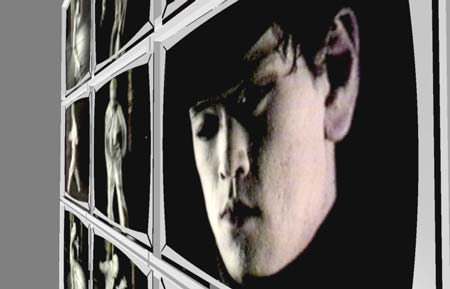 |
|
| |
TOKYO FOUR 1991 |
| A VIDEO
MATRIX BY STEINA |
No form of moving-image art comes
as close to musical composition as multiscreen
video, where the different channels of image and
sound are equivalent to musical polyphony, each
functioning like a voice in a musical ensemble.
And no multiscreen work is as spectacularly musical
as Steina’s. She works as a composer would,
playing on the visual equivalents of timbre, texture,
and tone. Tokyo Four is the audio-visual equivalent
of a string quartet. In one compositional strategy,
Steina begins by assembling a long single-channel
segment which represents the “melody,”
or what she calls the “ground track.”
Sometimes one screen is the melody and the others
are accompaniment, then another screen takes the
lead. A musical syntax emerges from this visual
point/counterpoint. . . .
TOKYO FOUR is organized around categories of imagery:
Shinto priests meticulously grooming their Zen
garden on New Year’s Eve; train conductors
monitoring rush hour crowds; elevator girls bringing
a superfluous, but charming High Touch to the
high tech world of the shopping malls, reminding
shoppers to watch their umbrellas and to not forget
their children; a segment about food, beginning
with the vertiginous fisheye lens in a supermarket;
and an emotionally charged metachoreog-raphy of
a dance troupe’s performance and curtain
call. Her compositional devices include flipping
or reversing an image and playing it at imperceptibly
different speeds on different screens, which gradually
all synchronize at the same speed. These strategies
are especially effective in the final movement
when the female dancer is bowing. The Lehars’
waltz the dancers use would be banal without the
manipulations of Steina’s spectacular visual
matrix, which transforms it into something at
once exotic and poignant. |
| —
GENE YOUNGBLOOD |
|
| |
| D E S C R I P T I O N |
| TOKYO FOUR is a four video, four
audio channel installation with twenty-three minute
repeating program. Each of the four laser disk
players provide one video and two audio sources
to 12 video monitors and four speakers. A video
synchronizer aligns the four channels of video
for synchronous playback. At the end of each cycle,
the program automatically returns and re-synchronizes
for a repeat performance. |
| |
|
|